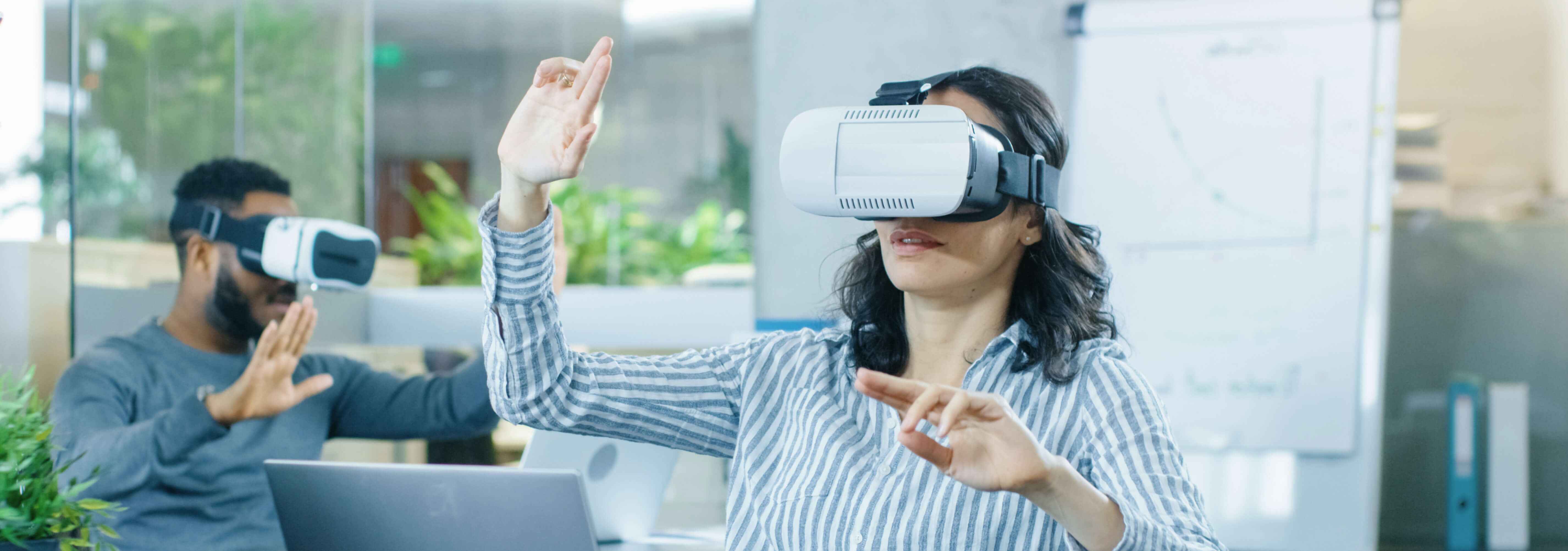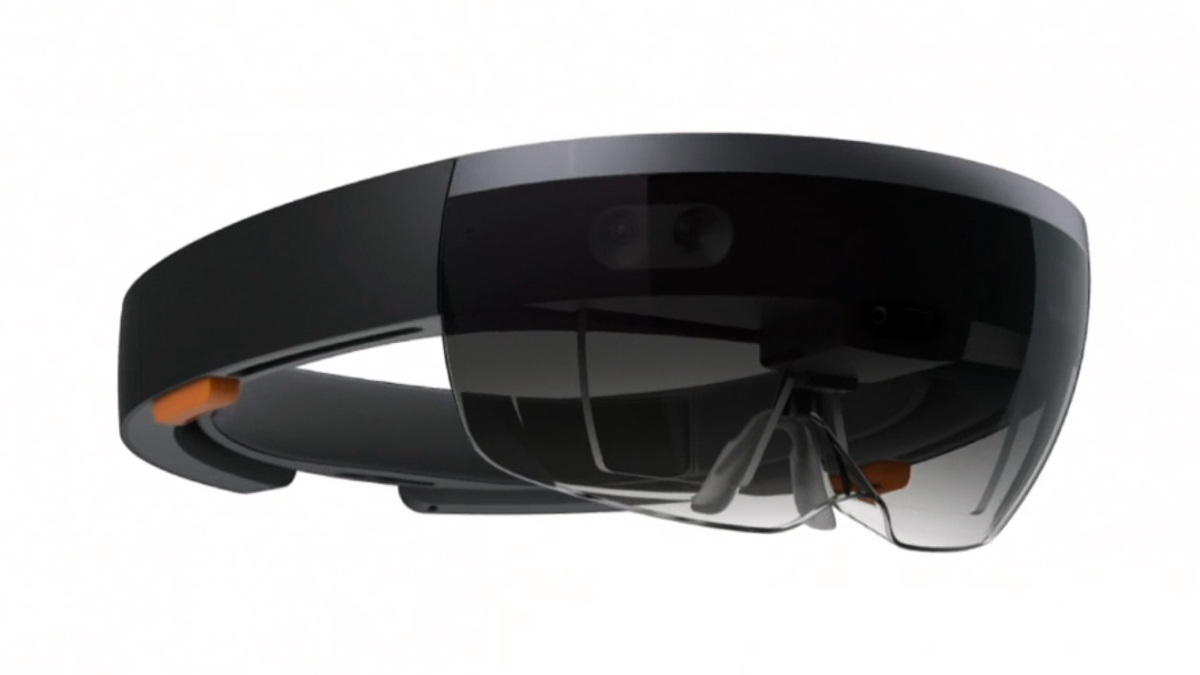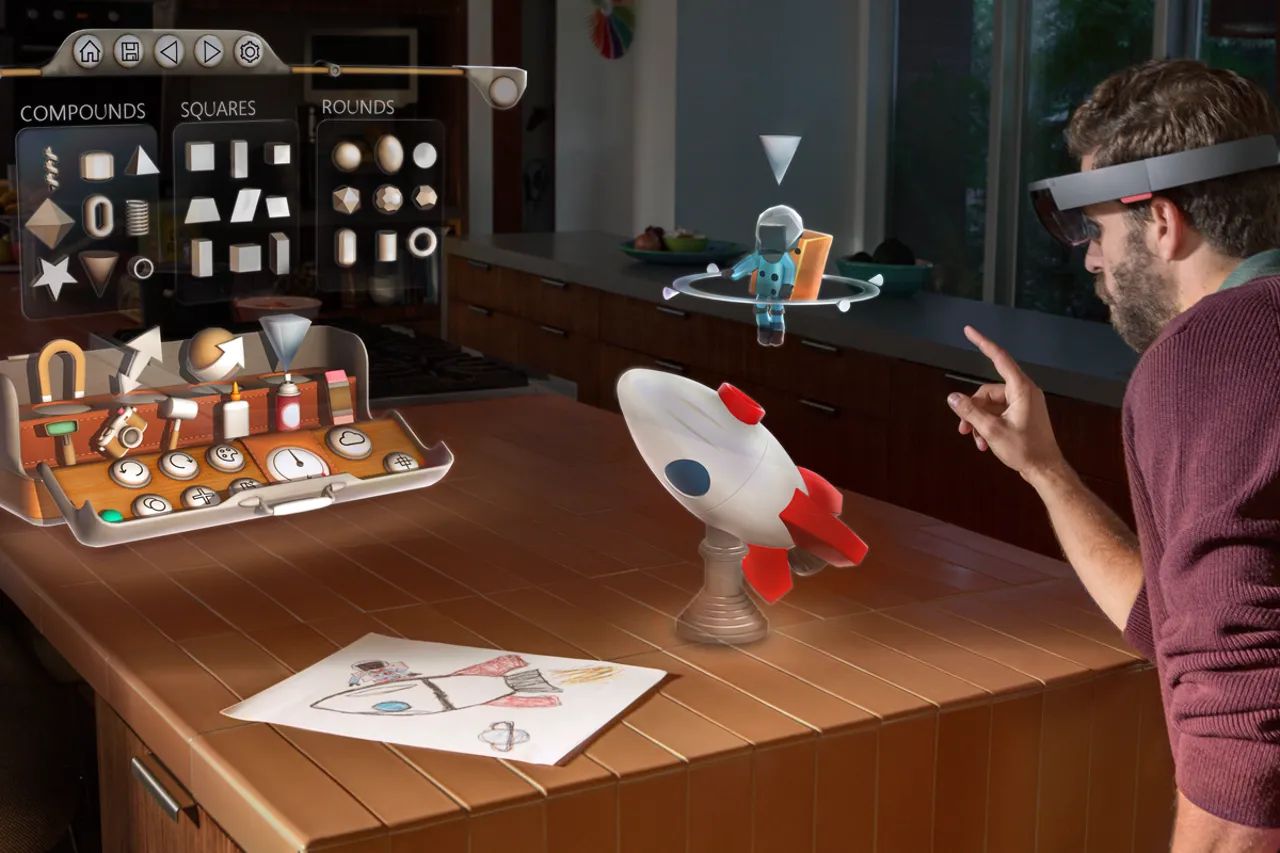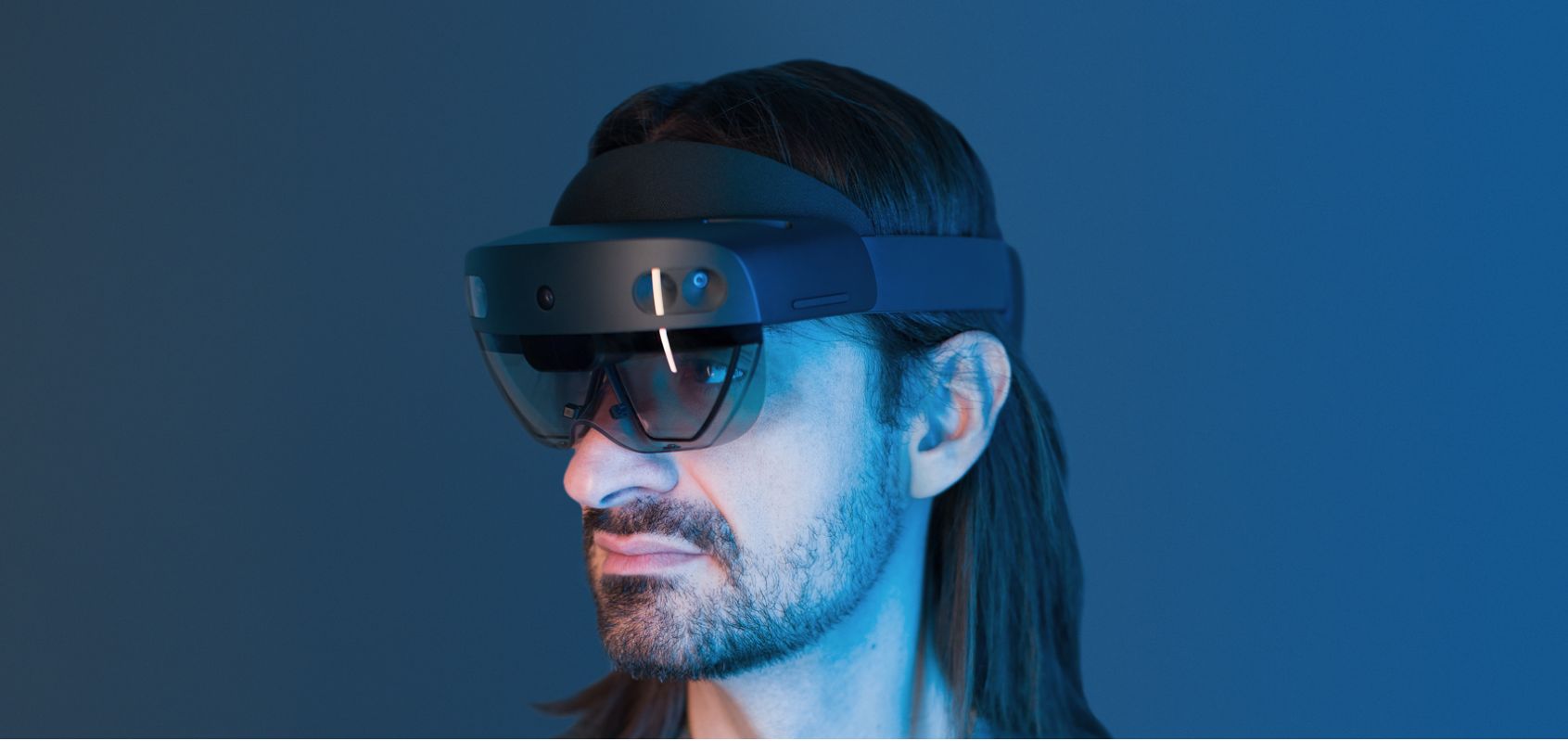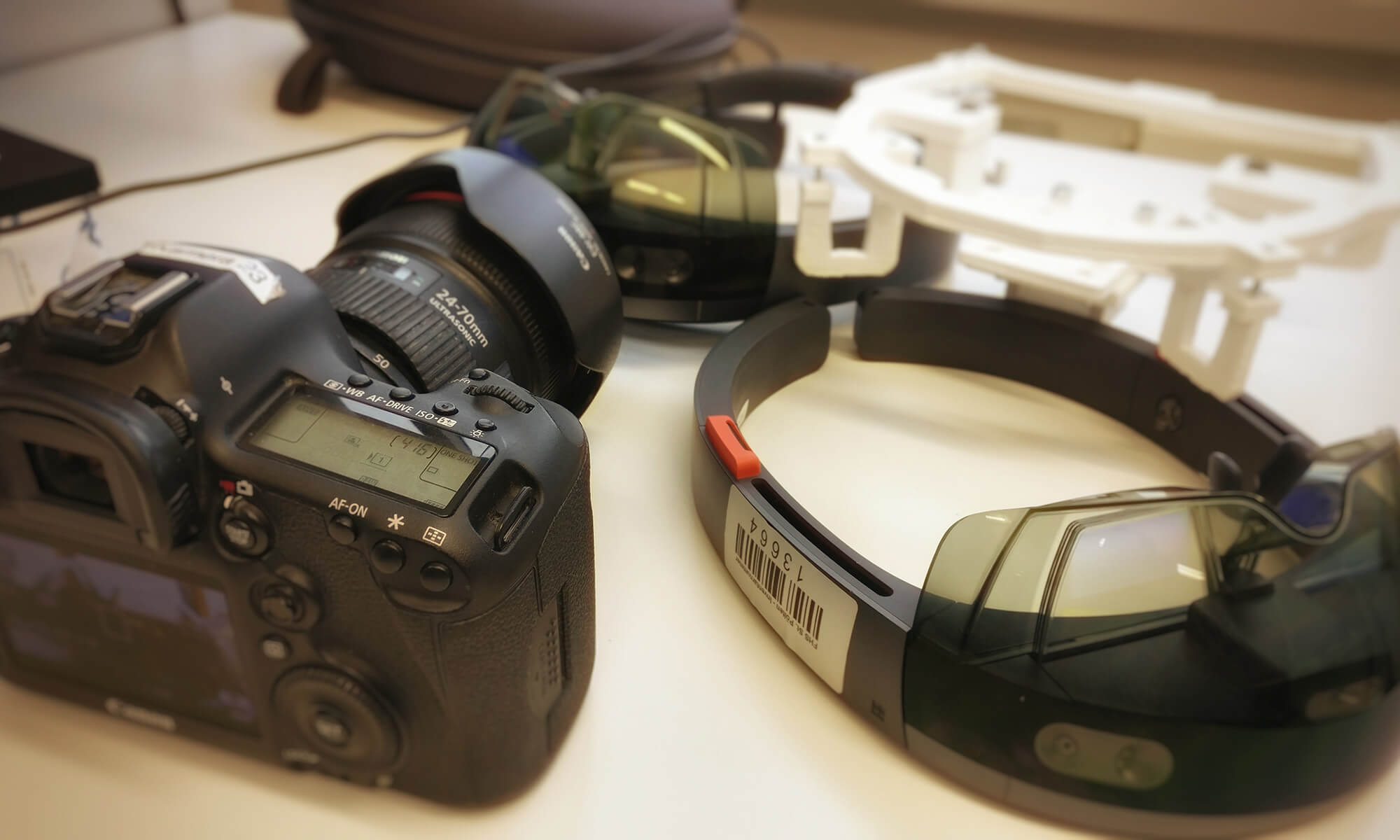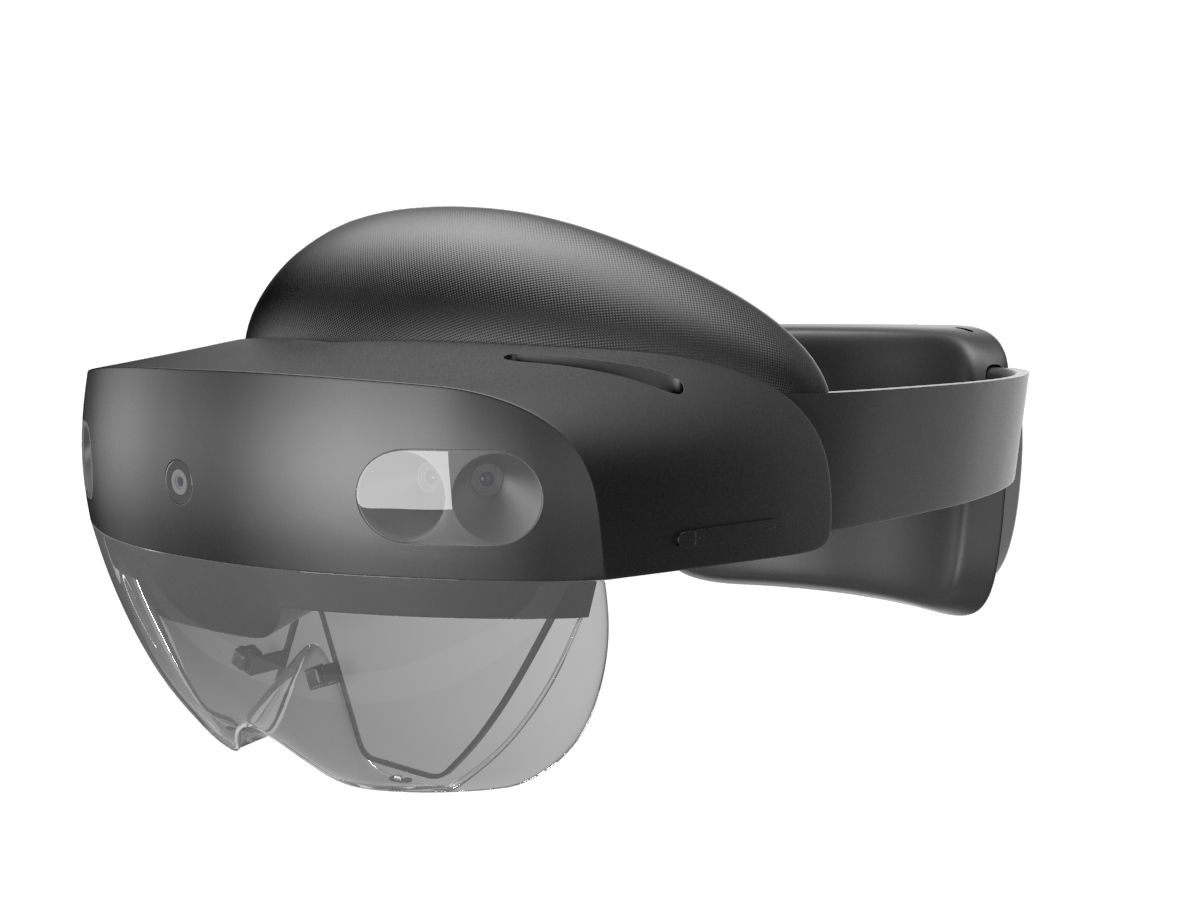Introduction
The HoloLens is a groundbreaking augmented reality (AR) device developed by Microsoft. With its advanced capabilities and immersive experiences, the HoloLens has the potential to revolutionize various industries and improve the quality of life for individuals in numerous ways. By blending the virtual and real worlds, this cutting-edge technology offers exciting possibilities for sectors such as healthcare, education, entertainment, manufacturing, communication, and more.
Unlike virtual reality (VR) headsets that transport users to entirely digital environments, the HoloLens overlays digital content onto the real world, seamlessly integrating computer-generated images with the user’s surroundings. This unique capability makes it an ideal tool for a wide range of applications, allowing users to interact with virtual objects while maintaining their awareness of the physical environment.
The HoloLens can enhance productivity, increase efficiency, and provide innovative solutions across various industries. From assisting in medical procedures to improving architectural design, the possibilities are endless. The device offers a new way of experiencing and engaging with digital content, enabling users to visualize complex concepts, collaborate remotely, and explore interactive virtual environments.
In this article, we will explore some of the key ways in which the HoloLens can be used to improve the quality of life in different sectors. From healthcare advancements to educational innovations and entertainment experiences, we will delve into the transformative potential of this groundbreaking technology and how it can positively impact our lives.
Healthcare
The HoloLens holds immense potential to revolutionize the healthcare industry by offering innovative applications for medical professionals and improving patient care. With its ability to overlay digital information onto the user’s field of view, the HoloLens can provide real-time guidance during surgical procedures, enhancing precision and reducing the risk of errors.
Surgeons can use the HoloLens to display patient data, CT scans, and other diagnostic images directly onto the operating field, allowing for more accurate placement of surgical instruments and implants. This technology enables enhanced visualization of anatomical structures, making complex surgeries more accessible and minimizing the need for invasive procedures.
Besides surgery, the HoloLens can also be used in medical training and education. Students and residents can experience virtual surgeries or medical simulations, providing a hands-on learning experience without the need for live patients. This improves knowledge retention and allows for practice in scenarios that are challenging to replicate in traditional educational settings.
Furthermore, the HoloLens can assist healthcare providers in remote consultations and collaborations. With telemedicine becoming increasingly popular, physicians can use the HoloLens to connect with patients in remote areas, providing real-time virtual consultations and guidance. The device’s ability to share a live view of the user’s perspective ensures accurate diagnosis and treatment recommendations, bridging the gap between patients and specialists.
Additionally, the HoloLens has the potential to improve patient experience and engagement. By creating interactive and personalized patient education materials, health professionals can use the device to educate patients about their conditions and treatment plans. This visual approach enhances patient understanding and compliance, leading to better health outcomes.
The HoloLens is also being explored for its potential in rehabilitation. By creating virtual environments and interactive exercises, the device can assist patients in their recovery journey, providing visual cues and real-time feedback. This gamified approach to therapy improves patient engagement and motivation, leading to faster and more effective rehabilitation.
In summary, the HoloLens has the ability to transform healthcare by improving surgical precision, enhancing medical training, enabling remote consultations, empowering patient education, and facilitating rehabilitation. The device opens up new possibilities for medical professionals and patients alike, ushering in a new era of augmented reality in healthcare.
Education and Training
The HoloLens has the potential to revolutionize the field of education by providing immersive and interactive learning experiences. With its augmented reality capabilities, the device can transform traditional classrooms into engaging and dynamic environments, enabling students to visualize complex concepts and explore virtual worlds.
One of the key advantages of the HoloLens in education is its ability to bring abstract concepts to life. Students can interact with three-dimensional models and simulations, allowing them to better understand complex theories in subjects such as mathematics, physics, and chemistry. This hands-on approach enhances comprehension and retention, making learning more enjoyable and effective.
Moreover, the HoloLens offers virtual field trips, allowing students to explore historical sites, visit far-off locations, and experience different cultures without leaving the classroom. This immersive experience broadens students’ horizons and enhances their understanding of the world, making learning more engaging and memorable.
In addition to enhancing the learning experience for students, the HoloLens can also transform teacher training programs. Educators can use the device to practice classroom management techniques, simulate challenging student scenarios, and receive real-time feedback. This enables teachers to refine their skills and implement effective teaching strategies, ultimately improving the quality of education.
The HoloLens also has the potential to support distance learning initiatives, particularly during times when physical attendance is not possible. By using the HoloLens, students can participate in virtual classrooms, engage in collaborative activities, and receive personalized instruction from teachers, regardless of their geographical location. This promotes inclusivity and equal access to education.
Furthermore, the HoloLens can facilitate medical and technical training. Medical students can practice surgical procedures and interact with virtual patients, gaining valuable hands-on experience before working with actual patients. Similarly, technical training programs can use the HoloLens to provide interactive simulations, allowing trainees to safely practice complex tasks and troubleshoot equipment.
In summary, the HoloLens has the potential to revolutionize education by offering immersive learning experiences, virtual field trips, enhanced teacher training, distance learning opportunities, and simulation-based training programs. By incorporating augmented reality into classrooms and training programs, the HoloLens opens up new possibilities for interactive and engaging education.
Architecture and Design
The HoloLens holds immense potential in the field of architecture and design, revolutionizing the way professionals conceptualize, visualize, and present their ideas. With its augmented reality capabilities, the device allows architects and designers to overlay virtual models onto the real world, enabling them to see and interact with their designs in a tangible way.
One of the key advantages of the HoloLens in architecture and design is its ability to provide spatial understanding. Architects can create virtual 3D models of buildings, allowing them to visualize and explore the design in real-world scale. This enables them to assess the relationship between different elements, identify potential flaws, and make informed decisions before construction begins.
The HoloLens also facilitates collaborative design processes. Multiple users can interact with the virtual model simultaneously, making it easier for teams to communicate, share ideas, and make collective decisions. This virtual collaboration eliminates the need for physical prototypes, saving time and resources in the design process.
Moreover, the HoloLens can assist in the presentation of design concepts to clients and stakeholders. Architects can use the device to showcase their designs in an immersive and interactive manner, enabling viewers to visualize the finished project and explore its various aspects. This enhances client understanding and engagement, ultimately leading to better project outcomes.
In the field of interior design, the HoloLens allows designers to overlay virtual furniture, decor, and finishes onto physical spaces. This enables clients to see how different design elements would look in their actual environment, facilitating better decision-making and creating a more personalized experience.
Additionally, the HoloLens can aid in urban planning and city development. By overlaying virtual models onto real-world landscapes, planners can assess the impact of proposed projects on the existing environment. This technology allows for better visualization of architectural interventions, ensuring they integrate seamlessly with the surrounding context.
In summary, the HoloLens offers architects and designers a powerful tool to enhance their workflows, improve design visualization, facilitate collaborative processes, and engage clients in a more immersive way. The device’s augmented reality capabilities bring designs to life, enabling professionals to create more innovative and impactful projects.
Entertainment and Gaming
The HoloLens has the potential to revolutionize the entertainment and gaming industry by providing immersive and interactive experiences like never before. With its augmented reality capabilities, the device allows users to engage with virtual content in their real-world environment, blurring the line between the physical and digital worlds.
One of the key advantages of the HoloLens in entertainment and gaming is its ability to create unique and engaging experiences. Users can interact with virtual characters, objects, and environments, bringing the game to life in their own space. This opens up endless possibilities for storytelling, puzzles, and interactive adventures, providing users with a truly immersive gaming experience.
The HoloLens also allows for multiplayer experiences, enabling users to interact and collaborate within the same augmented reality environment. This social aspect enhances the gaming experience, providing opportunities for cooperative gameplay and shared adventures. Players can see and interact with each other’s virtual avatars, making gaming a more interactive and social activity.
Additionally, the HoloLens offers exciting opportunities for mixed reality gaming, where virtual objects are seamlessly integrated into the real world. Users can race virtual cars on their living room floor, defend their homes from invading aliens, or create virtual sculptures in their backyard. This blending of physical and virtual elements creates a truly unique and captivating gaming experience.
Furthermore, the HoloLens has the potential to revolutionize the way we consume entertainment content. Users can watch movies, TV shows, and live events on virtual screens in their own environment, creating a personal and immersive viewing experience. This technology can transform the way we engage with media, offering new possibilities for content consumption and interaction.
Moreover, the HoloLens can be used for educational and informative experiences within the entertainment sector. Users can access interactive educational content, historical reenactments, virtual museum visits, and much more. This brings learning and exploration to life in a way that traditional media cannot replicate.
In summary, the HoloLens has the potential to revolutionize the entertainment and gaming industry by offering immersive and interactive experiences. From storytelling and multiplayer gaming to mixed reality experiences and personalized content consumption, the HoloLens opens up new possibilities for entertainment and gaming that were previously unimaginable.
Manufacturing and Construction
The HoloLens has the potential to transform the manufacturing and construction industries by offering innovative applications that improve efficiency, accuracy, and safety. With its augmented reality capabilities, the device enables professionals to visualize and interact with virtual models in real-time, enhancing the design, planning, and execution of projects.
One of the key advantages of the HoloLens in manufacturing and construction is its ability to assist in the design process. Engineers and designers can overlay virtual components and assemblies onto the physical environment, allowing for better visualization of the final product. This enables them to identify potential design flaws, optimize layouts, and streamline the manufacturing process.
The HoloLens also aids in assembly and maintenance tasks. By displaying step-by-step instructions and virtual overlays, the device guides workers through complex procedures, reducing errors and increasing efficiency. This technology enables workers to have hands-free access to critical information, enhancing productivity and ensuring consistency in assembly processes.
Furthermore, the HoloLens can be used for quality assurance and inspection purposes. Inspectors can compare virtual models with physical products, identifying discrepancies and ensuring adherence to specifications. This reduces the risk of defective products reaching the market and improves overall quality control.
Additionally, the HoloLens enhances collaboration and communication in manufacturing and construction settings. Multiple stakeholders can view and interact with the same virtual models in real-time, regardless of their geographical locations. This promotes effective collaboration, reduces the need for physical prototypes, and accelerates decision-making processes.
In the construction industry, the HoloLens aids in project visualization and planning. Architects, engineers, and contractors can overlay virtual building models onto real-world sites, allowing for better alignment between design intent and construction execution. This reduces errors, prevents rework, and improves overall project efficiency.
Moreover, the HoloLens enhances workplace safety by providing virtual training and real-time hazard detection. Workers can undergo virtual safety training, practicing procedures in simulated environments before entering physically hazardous spaces. The device can also detect potential hazards and provide real-time warnings, reducing the risk of accidents and injuries.
In summary, the HoloLens offers manufacturing and construction industries a powerful tool to improve design visualization, streamline assembly processes, enhance quality control, facilitate collaboration, optimize project planning, and enhance workplace safety. The device’s augmented reality capabilities pave the way for more efficient, accurate, and advanced manufacturing and construction practices.
Communication and Collaboration
The HoloLens offers transformative possibilities for communication and collaboration, revolutionizing the way individuals interact and work together. With its augmented reality capabilities, the device enables users to share virtual experiences and collaborate seamlessly, regardless of their physical location.
One of the key advantages of the HoloLens in communication and collaboration is its ability to create immersive virtual meeting spaces. Users from different locations can join a shared augmented reality environment, where they can see and interact with each other’s virtual avatars. This enhances the feeling of presence and facilitates more natural and engaging communication, even when participants are miles apart.
Furthermore, the HoloLens allows for real-time data sharing and annotation. Participants can overlay virtual elements, such as diagrams, 3D models, or documents, onto the shared space, facilitating collaborative problem-solving and decision-making. This eliminates the need for separate screens or physical documents, creating a more streamlined and dynamic collaboration experience.
The HoloLens also enables remote training and assistance. Experts can provide guidance and support to field technicians or remote workers by sharing their perspective through the HoloLens, overlaying instructions or information on the user’s field of view. This promotes knowledge sharing, accelerates problem resolution, and reduces the need for in-person presence.
In addition, the HoloLens can transform remote learning experiences. Educators can provide virtual classrooms, where students can interact with each other and the instructor, regardless of their physical location. This enhances engagement and fosters collaborative learning experiences, making education more accessible and inclusive.
Besides communication and collaboration, the HoloLens also enhances remote product design and development processes. Team members can visualize and interact with virtual prototypes, providing feedback and making design improvements in real-time. This reduces the need for physical prototypes, shortens development cycles, and enables faster time-to-market.
Moreover, the HoloLens aids in cross-cultural communication and language barriers. By utilizing real-time translation and interpretation features, users can communicate with others who speak different languages, breaking down language barriers and fostering global collaboration.
In summary, the HoloLens offers transformative possibilities for communication and collaboration. With its augmented reality capabilities, the device brings remote teams together in shared virtual spaces, enables real-time data sharing and annotation, facilitates remote training and assistance, enhances remote learning experiences, improves product design and development processes, and overcomes language barriers. The HoloLens revolutionizes the way we communicate and collaborate, fostering more seamless and impactful interactions across different industries and sectors.
Tourism and Travel
The HoloLens has the potential to revolutionize the tourism and travel industry by offering immersive and interactive experiences to travelers. With its augmented reality capabilities, the device allows users to explore destinations, learn about cultures, and enhance their overall travel experience.
One of the key advantages of the HoloLens in tourism and travel is its ability to provide virtual tours and experiences. Users can visit popular landmarks, historical sites, and museums from the comfort of their homes or hotel rooms. This enhances accessibility and provides an opportunity for travelers to preview destinations and plan their itineraries more effectively.
Moreover, the HoloLens can provide virtual guides and interactive information about tourist attractions. Users can access real-time information, historical facts, and interesting stories about the places they are visiting, enhancing their understanding and appreciation of the location’s cultural and historical significance.
The HoloLens also offers immersive language translation and interpretation features that can help travelers overcome language barriers. Users can view translated subtitles or hear translations in real-time, enabling them to communicate more effectively with locals, navigate foreign countries, and immerse themselves in the local culture.
Additionally, the HoloLens can enhance the in-person travel experience. Travelers can use the device to overlay virtual elements, such as directions or points of interest, onto their real-world surroundings. This improves navigation, provides personalized recommendations, and helps travelers make the most of their time in a new location.
The device can also bring historical sites and ancient ruins to life by overlaying virtual reconstructions of what the location would have looked like in its prime. This provides a contextual and enriched experience, allowing travelers to visualize the past and immerse themselves in history.
Furthermore, the HoloLens can enhance the post-travel experience by providing a platform for users to relive and share their travel memories. Users can record their experiences using the device and revisit them at any time, allowing for a more immersive and nostalgic recollection of their journeys.
In summary, the HoloLens offers transformative possibilities for the tourism and travel industry, providing virtual tours, interactive information, language translation, navigation support, historical reconstructions, and post-travel experiences. Through the device’s augmented reality capabilities, travelers can immerse themselves in the destinations they visit, enhance their cultural understanding, and create meaningful and memorable travel experiences.
Assisting People with Disabilities
The HoloLens has the potential to significantly improve the lives of people with disabilities, offering innovative solutions and empowering individuals to overcome physical and sensory limitations. With its augmented reality capabilities, the device can provide assistance and accessibility in various ways.
One of the key advantages of the HoloLens in assisting people with disabilities is its ability to enhance visual and auditory experiences. Individuals with visual impairments can use the HoloLens to overlay digital visual aids onto their real-world surroundings, improving their perception of their environment. This can include real-time object detection, navigation assistance, and increasing the visibility of important information.
Furthermore, the HoloLens can provide personalized and adaptive solutions for individuals with hearing impairments. The device can display real-time captions or offer support through sign language interpretation, making communication more inclusive and accessible.
In addition, the HoloLens can assist individuals with mobility impairments by providing virtual navigation aids and personalized guidance. Users can rely on virtual overlays to assist with navigation in both indoor and outdoor environments, facilitating independent movement and reducing reliance on physical assistance.
The HoloLens can also enhance accessibility in public spaces and buildings. By overlaying virtual signage and information, individuals with cognitive impairments or language barriers can easily navigate and understand their surroundings. This promotes independence and inclusivity in various settings.
Moreover, the HoloLens has the potential to offer rehabilitation and therapy applications for individuals with physical disabilities. The device can provide interactive exercises and virtual guidance for rehabilitation programs, allowing users to track their progress and engage in personalized therapy sessions.
Furthermore, the HoloLens can support individuals with neurodevelopmental disorders, such as autism spectrum disorder. Users can engage with customizable virtual environments that help with social skills development, sensory integration, and cognitive enhancement.
Additionally, the HoloLens has the potential to enhance accessibility in the workplace. The device can provide real-time assistance and virtual overlays to help individuals with disabilities perform their tasks more effectively, breaking down barriers and promoting inclusivity in the professional environment.
In summary, the HoloLens offers transformative possibilities for assisting people with disabilities, enhancing visual and auditory experiences, improving mobility and navigation, facilitating communication, fostering rehabilitation and therapy, promoting accessibility in public spaces, and supporting individuals with neurodevelopmental disorders. Through its augmented reality capabilities, the HoloLens opens up new opportunities for individuals with disabilities to live more independent, inclusive, and empowered lives.
Conclusion
The HoloLens is a groundbreaking augmented reality device that has the potential to revolutionize various industries and improve the quality of life for individuals in numerous ways. From healthcare advancements to educational innovations, from entertainment experiences to manufacturing efficiencies, the possibilities are endless.
In healthcare, the HoloLens can enhance surgical precision, improve medical training, enable remote consultations, empower patient education, and facilitate rehabilitation. The device has the potential to transform the way medical professionals operate, ultimately leading to improved patient care and outcomes.
In education and training, the HoloLens offers immersive learning experiences, virtual field trips, enhanced teacher training, distance learning opportunities, and simulation-based training programs. By incorporating augmented reality into classrooms and training programs, the HoloLens enhances engagement, promotes interactive learning, and fosters knowledge retention.
In various industries, including architecture and design, entertainment and gaming, manufacturing and construction, communication and collaboration, and tourism and travel, the HoloLens unlocks new possibilities for innovation, efficiency, creativity, and collaboration. The device enhances visualization, facilitates remote collaborations, improves project planning, strengthens communication, enhances customer experiences, and breaks down barriers.
Furthermore, the HoloLens has the potential to assist individuals with disabilities, providing access and support in various aspects of life. Whether it is enhancing visual and auditory experiences, improving mobility and navigation, facilitating communication, providing rehabilitation and therapy, or promoting inclusivity in public spaces and workplaces, the device empowers individuals to overcome physical and sensory limitations.
In conclusion, the HoloLens is a transformative technology that holds immense potential to revolutionize numerous industries and improve the quality of life for individuals. The device’s augmented reality capabilities offer new ways of experiencing and interacting with the digital world, opening up limitless possibilities for innovation, collaboration, and accessibility.







